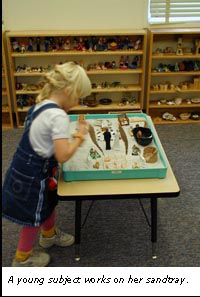 | |
 |
by Jeff van de Pol
Though Sand Tray therapy has scientific respect and popularity worldwide, some clinicians are concerned about the variety and subjectivity of conclusions on the meaning of sandtray dioramas. For instance, the interpretations of completed sandtrays tend to vary widely depending on the training of the therapist. With many practitioners following different psychological theories, the meanings assigned to the toys used in the sandtrays can shift dramatically from therapist to therapist. For example, a Freudian therapist might associate a subject's use of a crescent or snake in a sandtray with a sexual problem, whereas a Jungian might associate the same object with an affinity for nature. Barton and Shiraishi are quick to point out that even though interpretations of the same clinical situation often differ substantially, that does not mean they are "wrong." It is simply a fundamental fact of social science research. "We would never say that any particular interpretations are invalid," says Barton. "Rather, we believe that it might be also useful to look for more objective measures that are independent of any particular clinical theory."
Another important goal was to identify a group of objects common to all Sand Tray sessions. Barton explains: Therapist #1 at present may offer 2,500 toys for potential use on the tray, while therapist #2 might offer only 500 objects. This may not present any problem in making sense of their own clients' trays, but it creates severe limitations when trying to do comparative studies. If therapist #1 attempted to interpret a completed sandtray from therapist #2, or vice versa, the results would be problematic, as each therapist would be basing the interpretations on his or her own set of sandtray toys. "If a set of precisely identified objects could be defined and offered to therapists in a kit (much like the objects used in many individual IQ tests)," Barton continues, "objective measures and comparisons would be much easier to complete."
With such an enormous number of entries, errors from duplication, multiple entries, and rater fatigue became increasingly problematic. Lab access and security also became concerns, as each rater was initially required to come to Barton and Shiraishi's lab to physically handle the toys at each rating session; such excessive handling invariably led to damaged or lost toys.
The benefits of this change were immediately obvious. According to Shiraishi, "This new database dramatically reduced both data entry costs and the error associated with massive data entry. Moreover, we are now able to analyze the data as they are entered into the database instead of having to wait ten-plus weeks for the completion of the rating books." Further simplifying and streamlining the process, Shiraishi and Barton used a digital camera to photograph all the toys in extreme detail. After loading the pictures onto the computer and setting up a server for access, the raters were then able to independently view and rate the toys from home using the 85 agreed-upon characteristics, essentially eliminating security problems and further speeding up the lengthy data entry process.
Barton also hopes that future social science researchers will take advantage of what he and Shiraishi have learned and realize that with the application of a few pieces of hardware and software social scientists could potentially transform the way future research is conducted. "This present study is a prime example of how technology can be used in future psychological research," says Barton. "Many of the researchers in the social sciences have neglected the use of computers because their past projects have not intrinsically required the use of modern technology. We found ways to make the research project more efficient and more cost effective through the use of computer technology. The ability to conduct quality research that is both quicker and cheaper is no longer a dream for many scientists; it can be realized for many right now."
|
 Sand Tray Therapy: A Primer
Sand Tray Therapy: A Primer